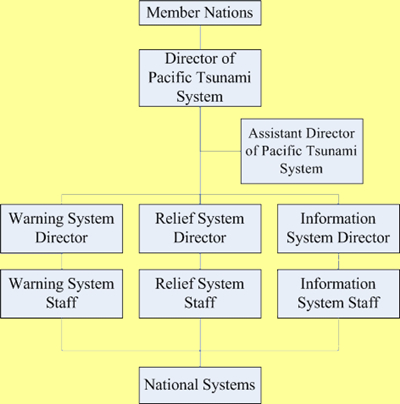

| This page summarizes the information presented in the funding and cooperation pages. See the funding and coordination pages for references. |
|
Again neither Peru nor Micronesia can afford to construct a system. Because of the international aspect of the organization, the international community will cover the costs of the system.
The NGO's will provide expertise in the fields and supplies for the creation of the depots. The United States will provide a substantial proportion of the funds, but the international community will provide more due to their increased role in the system. |
||||||||||
|
Initially, long term funding would most likely parallel the percentages used to create the initial network. Afterwards, it would be the responsibility of the director to create a budget and submit it to the the participating nations. The nations would then decide amongst themselves where the funds for the next year will be from. |
||||||||||
|
Relief would be coordinated through the central relief agency of the network. The agency would work to ensure supplies arrived quickly and efficiently to the nations that needed them. The supply depots would cover the people until international aid could arrive. Medical assistance would be mobilized immediately and first priority would be given to nations with little existing medical infrastructure, such as Micronesia. |
||||||||||
|
As opposed to the international system within the United Nations, an independent international system would have less bureaucracy above it, making it more effective and better able to fulfill its role. When compared to the existing system, the United States would participate because of decreased financial responsibility. Other nations would participate because of the increased influence they would have in the system. Overall, the system would be consolidated. This makes the system better in the long term, giving yet another reason to participate. |
||||||||||
|
The system would be created in place of the current Pacific tsunami network. A director would be in charge of the system to facilitated communication and similar direction between the directors of the warning, relief and information system. The warning director and staff would be in control of the warning network for the Pacific along with the alarm system. The relief director and staff would be in charge of making arrangements for aid before a tsunami and in coordinating relief efforts after a tsunami, including the management of NGO's. The information system director and staff would take over the role of the ITIC, advocating for tsunami networks and holding forums about tsunamis. |
||||||||||
|
When a signal is found by a local buoy, the evacuation signal would trip in the nation in which the buoy was located. The signal would then continue on to the national government as well as the International Pacific Tsunami Warning Center (IPTWC). The IPTWC would then examine the signal to determine if there was a tsunami. If confirmed, it would activate the warning system for the nation who received the signal and begin to activate other nations that the tsunami could hit. After each of these, a telephone call would be made to each government to confirm that the signal had been received. If the initial signal was false, the IPTWC would cancel the evacuation and call the nation in order to confirm the cancellation. |
||||||||||
|
The new system would absorb the International Tsunami Information Center (ITIC), which would then operate underneath the information director. The Pacific Tsunami Warning Center (PTWC) would also be included within the organization. |
||||||||||








